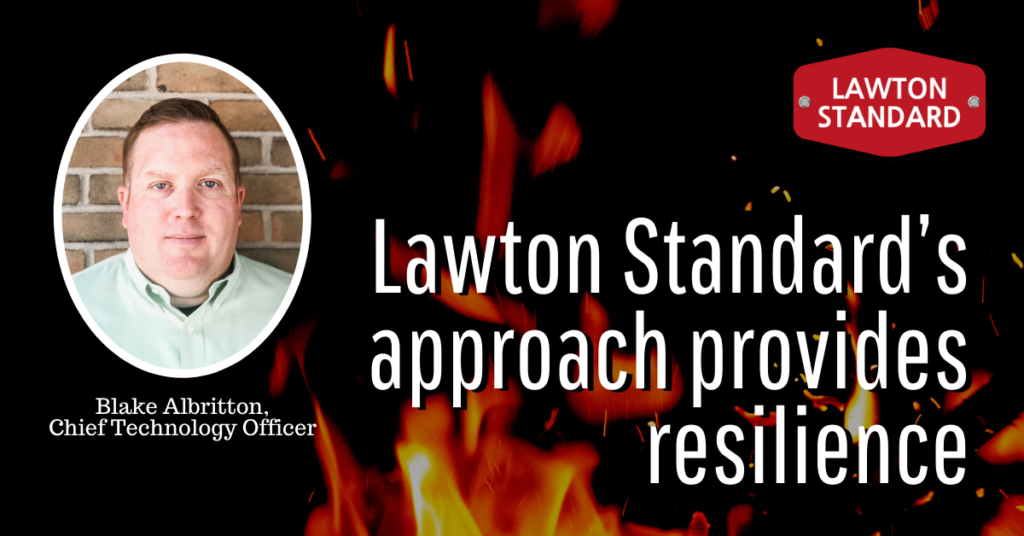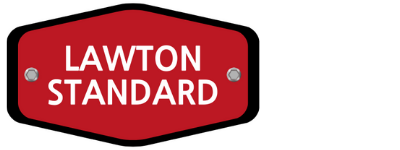
During times of increasing uncertainty and change, it appears that there is safety in numbers. Having a family of five foundries has enabled Lawton Standard to weather the pandemic, a major recession, labor shortages, and a war that has caused shortages and large swings in the prices of raw materials.
As the Chief Technical Officer (CTO) at Lawton Standard, Blake Albritton has helped to confidently guide the company on a path toward greater growth and efficiency, despite these turbulent times.
He’s in charge of several key areas of Lawton Standard, including engineering, maintenance, strategic sourcing, technical services, and research and development. He is also on the senior management team that evaluates potential acquisitions to expand the Lawton Standard family.
We recently chatted with Blake to learn more about his background and the challenges he’s dealing with today.
Can you tell us about your background, Blake?
I started as an engineer in the mining industry doing tool design, problem-solving, and technical sales support work for a manufacturer of contractor tools and rock drilling consumables. In 2012, I had an opportunity to become the technical director of a foundry, where I got deeply involved in production management, which was still very engineering-focused. I joined Temperform in 2017 and was instrumental in putting together its acquisition by Lawton Standard.
One of my strengths is problem-solving. Quality is a big part of my focus. A part of quality in a manufacturing environment is being able to solve problems in real-time. Not just looking for creative band-aids that may be a temporary fix but looking for root causes and solving those. I never set out to become a leader, but the type of problem-solving roles I’ve held have lent themselves to taking on a leadership role in the organization.
Is part of your focus helping Lawton Standard to integrate each foundry into the family?
Being part of the acquisition team is a double-edged sword because not every foundry we’re looking at is in a condition where it can run itself. One of our considerations is how much work is it going to take from our teams to support an ongoing operation? Do they need help with engineering, management, quality, or safety? And from a bigger picture standpoint, do we have the bandwidth to address those needs? Assessing each operational aspect of these businesses is a key part of our due diligence process.
Recent world events have caused some major volatility in the prices and availability of metals. How have they affected Lawton Standard and its foundries?
Ukraine and Russia have always been big suppliers of pig iron. With the war between those two countries, all that capacity was suddenly removed from the market. We scrambled during the last two months to secure supplies of pig iron as many months out as possible. Right now, we’re good through at least mid-summer, if not fall of this year, depending upon the material.
Magnesium ferrosilicon is used in the production of ductile iron. That material has experienced some scarcity. The price of nickel bounced all over the place for a while, but it now seems like it has stabilized.
For many of these metals, we have some extra leverage because we’re buying in volume for multiple foundries. So, we’ve been able to get on allocation with many of our distributors to guarantee supply, despite the shortages and big price fluctuations we’ve all heard about.
How does this affect the foundries’ ability to formulate the recipes of materials they need to produce castings for their customers?
One of the things we did was to adjust our charge calculators (the recipes to achieve the chemistry needed to produce materials for castings) across the Lawton Standard family so that we’re using less pig iron. We’re trying to stretch out our current supply.
Fortunately, in terms of melt chemistry, there are many different ways to end up with the same result. But all of those trade-offs have costs associated with them. So we’re trying to make the most economical substitutions we can to get us through the current supply and pricing challenges. Longer-term, as things stabilize, we’ll move back to charge calculators that are more economically feasible for our foundries.
Does being a family of foundries give Lawton Standard an advantage when it comes to procuring materials?
Definitely. There’s an advantage to pooling our resources. We’re able to buy a bigger piece of the pie when we’re sourcing for four or five foundries, not just one.
Let’s talk about engineering. What are the biggest challenges Lawton Standard is facing in that area?
Like most manufacturers today, we need more engineers. Fortunately, we’ve got a core team of folks who are skilled, qualified, and dedicated. As we add scope and scale geographically to Lawton Standard, one of our considerations is making sure we have enough engineering resources to meet each facility’s needs.
Some foundries are not close to major metropolitan areas. That means a smaller local pool of labor. In those situations, we’ve been experimenting with several models, including assigning some engineers to the platform level. They can travel to our foundries and apply their skills when and where they’re needed.
This model also enables us to bring engineers from multiple foundries together to solve our customers’ biggest casting problems. We did that last summer for a Penn-Mar customer, as part of an Iron 101 event. It was very successful. Having access to a deep bench of engineering expertise across the family is a unique feature of the Lawton Standard toolbox.
One of your responsibilities is standardizing processes to optimize operations at all Lawton Standard foundries. What’s involved in that part of your role?
When it comes to engineering tasks, standardization is always one of our top three priorities. One excellent example is basic foundry principles. Ideally, people ought to be trained on them in the same way at each of our facilities. This is especially important as we onboard new people.
Many tasks are more or less universal across all of our sites. Our goal is to come up with standard practices and procedures so there’s more uniformity in the way they’re handled at every Lawton Standard facility. It’s all about replacing the one-off, proprietary ways of doing things with a more universal set of approaches, wherever that makes sense.
This all sounds great from an internal efficiency standpoint. But how do all of these changes benefit Lawton Standard customers?
Our ultimate goal is to court blue-chip customers, who have very high expectations. We want to be a multi-metals platform that is a one-stop-shop for iron and steel castings. Once we get to the point where we have integrated management and quality systems, all supplier quality audits will be handled at the corporate level by Lawton Standard. We will sell our services as Lawton Standard, and then place the work in the foundry where it makes the most sense.
As business returns to normal, we’re starting to have conversations with large capital equipment manufacturers. We’re meeting with executives who are at a different level than we’ve ever had access to before. We’re asking them as consumers of castings, “What do you need? How can we help you fill those needs?” Those dialogues aren’t just about iron and steel castings but all of the services associated with them, such as machining and fabrication.
Our goal is to position Lawton Standard to better serve our customers than any other foundry. We’re just starting to hit our stride on that objective. The best is yet to come.
As Lawton Standard grows, do you believe it’s adding capacity and strength to the U.S. foundry industry?
One of the things that we’re doing is protecting American manufacturing capacity with an eye on re-shoring. Our goal is to elevate, professionalize and operate legacy foundries with up-to-date safety, quality, and management systems. We’re trying to preserve and create new capacity for American casting manufacturing and support the needs of current and potential customers. I’m happy with the progress we’re making toward that goal.
